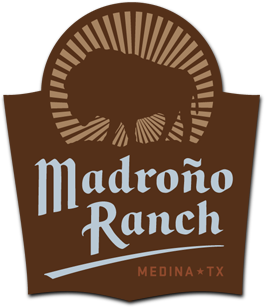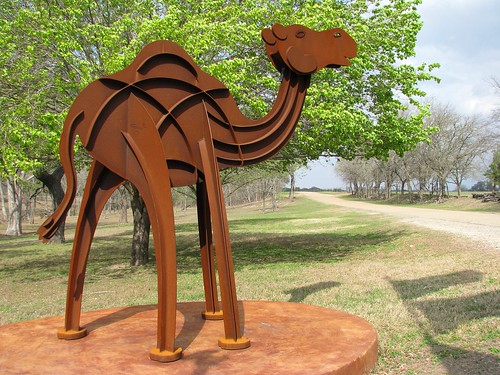Susan Orlean’s wonderful story on mules in the military in this week’s issue of The New Yorker mentions one of my favorite, and most unlikely, episodes of Hill Country history: the U.S. Army’s Great Texas Camel Experiment of the 1850s.
Ultimately, the experiment was a failure; in Orlean’s words, “The camels were superior in terms of strength, but they were vicious, tended to cough up foul-smelling chunks of food, and made horrible groans and roars that terrified the horses.” Still, enough of the beasts went AWOL that for several decades unwary sojourners in the American Southwest occasionally found themselves face to face with a living, spitting embodiment of Oriental exoticism.
Before the Civil War, much of Texas was considered to be part of the “Great American Desert,” a vast area of the Southwest that was still largely uninhabited and considered unsuitable for agriculture. American expansionism was about to prove that characterization wrong, at least in the short term, though Timothy Egan’s terrific book The Worst Hard Time: The Untold Story of Those Who Survived the Great American Dust Bowl vividly describes the horrific long-term result. But in the mid-nineteenth century, the War Department had to figure out a way to protect settlers and supply lines in this fearsome territory, and decided that using camels, instead of horses or mules, to carry troops and freight might be one way to do so.
The story of the Texas camel experiment actually begins in Florida, where Col. George H. Crosman apparently first thought about using camels for military purposes as far back as 1836. Crosman eventually asked Maj. Henry C. Wayne to look into the idea, and Wayne eventually reported to Secretary of War Jefferson Davis that the experiment would cost a mere $30,000. Congress duly authorized the expenditure in March 1855, and a little over a year later, on April 29, 1856, the naval storeship Supply arrived in Indianola, Texas, carrying thirty-three of the beasts (both one-hump Arabians and two-hump Bactrians), including one calf that had been born at sea, and three Arabs and two Turks whose job it would be to tend the creatures. The crossing had not been easy; the crew had to tie the camels to the deck during storms so they wouldn’t slide overboard, and the animals proved to be susceptible to seasickness.
On June 4, Wayne finally started his exotic caravan westward toward Camp Verde, south of Kerrville, pausing in Victoria to have the camels clipped. The industrious Mrs. Mary A. Shirkey of that town spun and knit a pair of camel hair socks as a gift for President Franklin Pierce, but Pierce reportedly found them so foul-smelling that he refused to wear them.
Wayne put the camels to work ferrying supplies between Camp Verde (a little over ten miles east of the future site of Madroño Ranch, as the crow flies) and San Antonio, with encouraging results. A second boatload of camels arrived in 1857, and some made the long trek to new quarters in California. An officer who led a caravan to the Big Bend country noted in his journal that the camels “performed most admirably,” adding that “No such march as this could be made with any security without them.”
Unfortunately, however, reports soon surfaced that the camels’ wide, soft feet, perfectly adapted for crossing desert sands in North Africa and the Near East, were not well suited to the rocky terrain of the the American Southwest. In addition, the soldiers were not fond of the camels, and vice versa; the officer who led the expedition to California noted that the beasts smelled bad and tended to bite or spit at the troops, and the horses and mules were unable to keep up with them.
Eventually, thanks in part to the complications brought on by the Civil War, the army decided to get out of the camel business. Some of the animals were sold to zoos, circuses, and mine operators. Others were simply turned loose to wander the Southwest; in 1885, the five-year-old Douglas MacArthur was terrified when he unexpectedly encountered one of the unlikely beasts near an army fort in New Mexico. Ten years later, the San Francisco Chronicle noted that “Many a passenger on the Southern Pacific railroad trains has had a sight of some gaunt, bony and decrepit old camel away off in the distance.” Today, the last of the original camels has long since disappeared, though a metal statue in front of the Camp Verde General Store commemorates their presence, and the Texas Camel Corps, a dedicated group of enthusiasts, keeps a number of the animals for pack trips, commercials, Christmas pageants, and the like.
Medina’s Early Days, one of the late Dorothy Hatfield Ferguson’s books of local history, includes the reminiscences of James Washington “Okra” Walker, who worked with the camels at Camp Verde. Walker was born in 1847, and in 1862, with the Civil War underway, decided to join the army and have a share in the fighting. Instead, much to his chagrin, the fifteen-year-old orphan found himself assigned to take care of the camels at Camp Verde. Looking back on the experience years later, Okra grudgingly admitted that the camels did have some advantages over other beasts of burden, principally “the ability to do without water for an incredibly long time,” but he never really warmed up to them, noting that “they weren’t as easy to look at as a good cuttin’ pony.” Moreover, they seemed much given to malingering, held grudges for any perceived mistreatment, and had the habit of spitting on those they didn’t like. “They also frightened the mules and horses and generally looked mighty out of place.”
When the experiment finally ended, Okra Walker, for one, was not sorry to see them go: “I guess I’d fooled with those beasts so long, and was [so] disgusted that I’d had to herd camels instead of fighting in the Civil War, that I never as much [as] asked one question pertaining to those camels or the buyer’s plans for them…. When those camels left Camp Verde, they went out of my life forever. I shouted after them, ‘Thank God you’re gone!’”
We have no plans to acquire camels for Madroño—I’m pretty sure Robert, our manager, would kill us if we did—but I like to imagine them roaming the ranch’s hills like the aoudads and other fugitive exotics we occasionally see today. And who knows? Perhaps the great-grandchild of some Arabian or Bactrian import is still out there, running free and gazing down at us with that inimitable camelicious mixture of disdain and amusement, sneering, “I’ll never be your beast of burden.”


Howdy guys. Thanks for keeping the memory of the US Army Camel Experiment alive. Thanks also for the link to my site.
Doug Baum
http://www.texascamelcorps.com